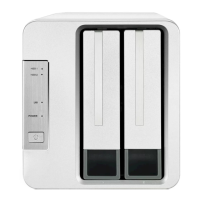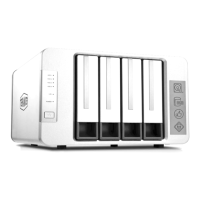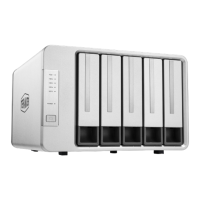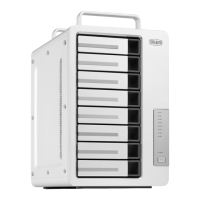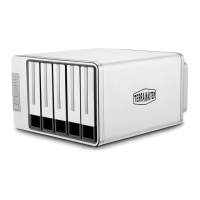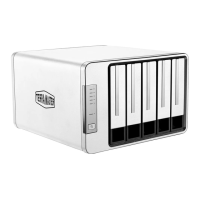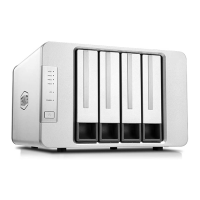Do you have a question about the TerraMaster F2-221 and is the answer not in the manual?
Lists the items included in the TNAS package, such as the unit, power core, and adapter.
Details the panel and rear cover illustrations of the TNAS unit, identifying key components.
Explains the meaning of various indicators and buzzer sounds for device status monitoring.
Discusses the requirements and types of hard drives compatible with the TNAS device.
Provides step-by-step instructions for connecting the TNAS device to the network and power.
Describes the TNAS PC desktop application for searching, logging in, and managing the device.
Introduces TerraMaster's Operating System (TOS) specifically developed for TNAS devices.
Instructions for downloading and using the TNAS mobile app for accessing files on mobile devices.
Locating the TNAS device on the network using the TNAS PC application before initialisation.
Initiating the device initialisation process through the TNAS PC application by clicking 'Start'.
The TNAS system detects the installed hard drive, proceeding to the next step if successful.
Assessing the health status of the installed hard drives to ensure optimal performance.
Installing the TerraMaster Operating System (TOS) on the device, either online or manually.
Configuring essential settings like password, device name, and time zone for the TNAS.
Setting up administrator password and security mailbox for authentication and password recovery.
Selecting RAID type and creating RAID volumes with hard drive formatting.
Storing files using Samba or AFS file services via the TNAS PC application.
Accessing advanced features like user management and system monitoring via TOS.
| RAID levels | 0, 1, JBOD |
|---|---|
| RAID support | Yes |
| Storage drive size | - \ |
| Storage drive capacity | 0 GB |
| Supported file systems | BTRFS, FAT32, HFS+, ext3, ext4 |
| Storage drive interface | - |
| Storage drives installed | No |
| Storage drive sizes supported | 2.5, 3.5 \ |
| Supported storage drive types | HDD & SSD |
| Total installed storage capacity | 0 TB |
| Maximum supported storage capacity | 32 TB |
| Number of storage drives installed | 0 |
| Number of storage drives supported | 2 |
| Supported storage drive interfaces | Serial ATA |
| Stepping | B1 |
| Tjunction | 105 °C |
| Processor code | SR2Z8 |
| Processor cache | 2 MB |
| Processor model | J3355 |
| System bus rate | 5 GT/s |
| Processor family | Intel® Celeron® |
| Processor socket | BGA 1296 |
| Processor codename | Apollo Lake |
| Processor frequency | 2 GHz |
| Processor cache type | Smart Cache |
| Processor lithography | 14 nm |
| Processor manufacturer | Intel |
| Processor package size | 24 x 31 mm |
| CPU configuration (max) | 1 |
| PCI Express slots version | 2.0 |
| Processor boost frequency | 2.5 GHz |
| Processor operating modes | 64-bit |
| PCI Express configurations | 1x2+2x1, 4x1 |
| Thermal Design Power (TDP) | 10 W |
| On-board graphics card model | Intel® HD Graphics 500 |
| Maximum internal memory supported by processor | 8 GB |
| Internal memory | 2 GB |
| Maximum RAM supported | 10 GB |
| Ethernet LAN data rates | 1000 Mbit/s |
| Supported network protocols | CIFS/SAMBA, NFS, FTP, TFTP, HTTPS, SSH, iSCSI, SNMP, SMTP |
| USB 2.0 ports quantity | USB 2.0 ports have a data transmission speed of 480 Mbps, and are backwards compatible with USB 1.1 ports. You can connect all kinds of peripheral devices to them. |
| Chassis type | Desktop |
| Cooling type | Active |
| Fan diameter | 80 mm |
| Product color | Gray |
| LED indicators | HDD, LAN, Power |
| Number of fans | 1 fan(s) |
| Type | NAS |
| Noise level | 18.6 dB |
| Device class | Home & Home Office |
| Share folder | 256 |
| Backup features | Cloud, USB drive |
| Number of users | 512 user(s) |
| Browser supported | Google Chrome 48, Microsoft Internet Explorer 9, Mozilla Firefox 30, Apple Safari 4.5 |
| Security algorithms | AES, HTTPS, SNMP, SSH |
| Output voltage | 12 V |
| AC input voltage | 100-240 V |
| AC input frequency | 50 - 60 Hz |
| Power supply location | External |
| Power consumption (typical) | 25.6 W |
| Power supply unit (PSU) capacity | 40 W |
| Cables included | AC, LAN (RJ-45) |
| Storage temperature (T-T) | -20 - 60 °C |
| Operating temperature (T-T) | 5 - 40 °C |
| Operating relative humidity (H-H) | 5 - 95 % |
| Sustainability certificates | RoHS |
| Certification | FCC, CE, CCC, KC |
| Number of execution units | 12 |
| Maximum number of PCI Express lanes | 6 |
| Memory types supported by processor | DDR3L, LPDDR3-SDRAM, LPDDR4-SDRAM |
| Intel Identity Protection Technology version | 1.00 |
| Intel Small Business Advantage (SBA) version | 0.00 |
| On-board graphics card base frequency | 250 MHz |
| On-board graphics card burst frequency | 700 MHz |
| Number of displays supported (on-board graphics) | 3 |
| Processor ARK ID | 95597 |
| Depth | 133 mm |
|---|---|
| Width | 119 mm |
| Height | 227 mm |
| Weight | 1470 g |
| Package depth | 170 mm |
| Package width | 220 mm |
| Package height | 258 mm |
| Package weight | 2320 g |

